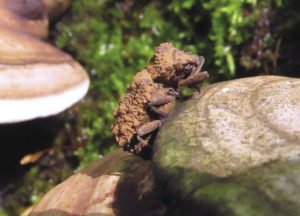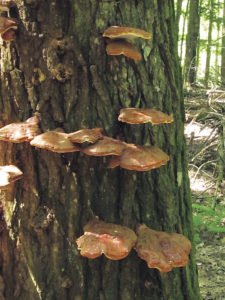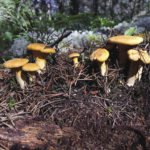North Shore—Everyone knows the tropical rainforest and other faraway lands are flush with strange and fascinating insects. But there are some unusual and exotic insect residents here in the Northern Wilds too, like the forked fungus beetle.

Most people have never heard of it or seen it, but the forked fungus beetle is widespread in the region and is also found in many forested areas from the Great Plains to the Atlantic and Gulf coasts. Scientists call it Bolitotherus cornutus, and what it lacks in size, color and speed it makes up for in unique appearance and interesting habits. A mere half-inch long, forked fungus beetles sport no bright colors or blinking lights, and they don’t do anything glamorous like eat mosquitoes or pollinate alfalfa. They aren’t fuzzy and buzzy like bees. They have lumpy brown faces that only a mother could love.
Both sexes are covered in warty tubercles, and the males with their namesake forked “horns” resemble miniature six-legged dinosaurs. Males actually have two sets of horns, one small pair above the mouth and a larger pair behind the head on the thorax. These horns come into play when arguing over females. Males will use their horns to pry other males off of females they are courting, and males with larger horns have an advantage in these tussles.
Not surprisingly, their diet consists of fungi, and fungi in the genus Ganoderma are preferred over most other types. This preference for easily found fungi that many people are already familiar with provides an easy way to find the beetles, and they are worth looking for.
Anyone who has spent time in a mature deciduous forest has probably seen Ganoderma. These bracket or shelf fungi grow in clusters and protrude horizontally from the lower trunk of old, rotten or damaged trees. They are usually brown, gray or red, and one known as Reishi is sought for its purported medicinal properties. Another species is known as artist’s conk, because the lower surface is white and can be used for writing or artwork. They often occur on old sugar maple and hemlock stumps, but they can also occur on other species.
It’s difficult to find significant growths of these fungi between late spring and late summer without finding a forked fungus beetle. Holes in the brackets about a quarter inch wide are a good sign that the beetles are there. They are well-camouflaged and look like a chunk of bark or woody debris at first glance, but with practice it gets much easier to see through their disguise. They can be found on both upper and lower surfaces of the brackets and sometimes on the adjacent tree bark or in crevices and woodpecker holes.

Although primarily nocturnal, the forked fungus beetle can also be active during the day. Feeding, courtship and mating can sometimes be observed during the day in well-shaded maple or hemlock stands. Courtship lasts several hours, during which the male climbs aboard the female facing the opposite direction and strokes the female’s head and thorax with his hind legs and abdomen until she decides he is egg-worthy. For copulation, the male turns around and faces the same direction as the female. The male will stay with the female for up to several hours after mating in a behavior known as mate guarding. This prevents other males from mating and ensures that the first male’s sperm actually fertilizes eggs.
Females lay one or two eggs at a time in cracks of the fungi, where the larvae feed, grow and pupate into adults that can live several years. Females that overwinter as adults lay eggs in late spring and these mature into adults by fall. Overwintering larvae emerge as adults during the summer and lay eggs in the fall, and the subsequent larvae complete the cycle by overwintering. Since shelf fungi are very durable and they may regrow on the same tree for many years, it’s often possible to find the beetles at the same tree for several years.
Although forked fungus beetles are able to fly, they rarely disperse more than a few hundred feet. There are some exceptions though. In one study, a beetle moved over a half-mile in one day.—Wayne P. Steffens



